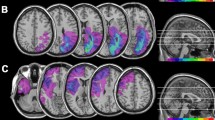Abstract
Electroencephalography (EEG) coherence provides a measure of functional correlations between two EEG signals. The present study was conducted to examine intrahemispheric EEG coherence at rest and during photic stimulation (PS; 5, 10 and 15 Hz) in ten unmedicated patients with presenile dementia of the Alzheimer type (AD; mean age at onset 56 years). In the resting EEG, the AD patients had significantly lower coherence than gender- and age-matched control subjects in the alpha-1, alpha-2 and beta-1 frequency bands. The EEG analysis during PS also showed that the patients had significantly lower coherence in the frequency corresponding to PS at 10 and 15 Hz. In this study, the changes in coherence from the resting state to the stimulus condition (i.e. PS-related coherence reactivity) were examined. The patients were found to show significantly smaller coherence reactivity to PS at 5 and 15 Hz. These findings suggest that, in addition to the resting state, AD patients have an impairment of intrahemispheric functional connectivity during PS. They also suggest that AD shows a failure of PS-related functional reorganization.
Similar content being viewed by others
Author information
Authors and Affiliations
Additional information
Received: 5 August 1997 / Accepted: 18 June 1998
Rights and permissions
About this article
Cite this article
Wada, Y., Nanbu, Y., Kikuchi, M. et al. Abnormal functional connectivity in Alzheimer’s disease: intrahemispheric EEG coherence during rest and photic stimulation. European Archives of Psychiatry and Clinical Neurosciences 248, 203–208 (1998). https://doi.org/10.1007/s004060050038
Issue Date:
DOI: https://doi.org/10.1007/s004060050038




